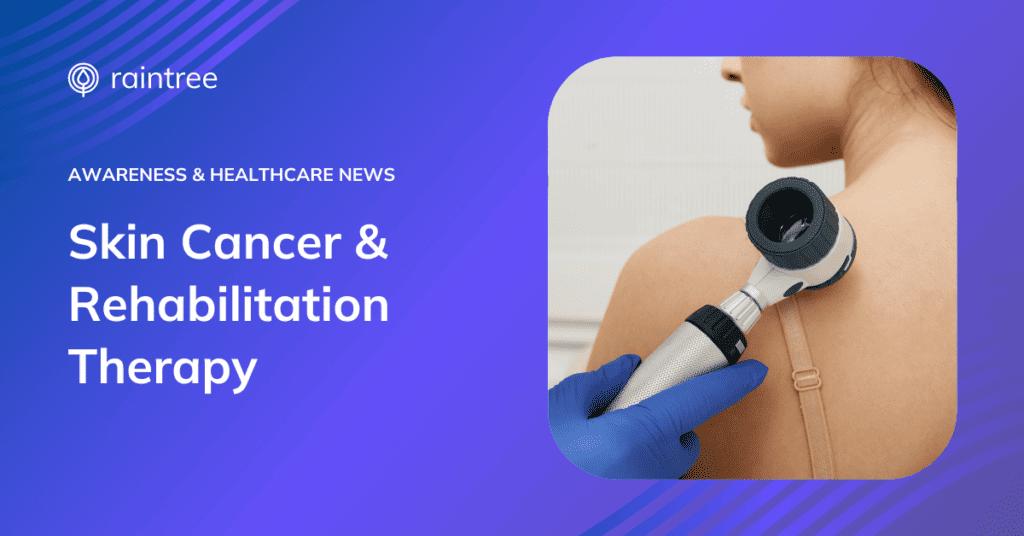
Summertime means soaking up the sun’s rays, drinking in that vitamin D, being physically active, and having a great time doing it! However, it can’t all be fun and games.
Excessive exposure to the sun’s ultraviolet (UV) radiation comes with the risk of sun damage to skin cells that could cause skin cancer, the most common form of cancer in the United States. Did you know that skin cancer rehabilitation and treatment can involve occupational and physical therapy? Learn more about skin cancer and how the therapy and rehab field plays a part in recovery.
What Are UV Rays?
The sun emits UV radiation, which produces vitamin D, a vital nutrient our bodies need to flourish. But like most good things, moderation is key. Too much exposure to UV radiation is a major risk factor for skin problems such as sunburn, premature aging, and eye damage, not to mention it could even interfere with certain medications, or potentially cause skin cancer!
UVA and UVB Rays
UV radiation is a form of natural energy produced by the sun. While there are many forms of radiation, there are two types of UV radiation that pose the risk of skin cancer. Ultraviolet A (UVA) is associated with premature skin aging, and ultraviolet B (UVB) causes skin burning or sunburn. While UVA and UVB impact the skin in different ways, both have the potential to be very harmful. Just remember, it’s not possible to undo sun exposure, only to minimize damage. That’s why the best treatment for skin problems is to take proactive steps to prevent them outright!
How to Protect Against Skin Damage
Rain or shine, UV rays can damage your skin, so it’s essential to take precautions that protect your skin during the summer months as well as year-round.
- Shade. Periodically staying under a shelter of some sort, such as a tree or umbrella, can reduce the risk of skin damage. Wearing a wide-brimmed hat can also provide additional sun protection.
- Clothing. While not ideal during the summer, long-sleeved shirts, pants, and longer skirts can shield the skin from the sun. Note, fabrics that are tightly woven and dark colors may be more protective than lighter colors.
- Sunglasses. These reduce the risk of cataracts and protect the eyes from UV radiation. Wrap-around styles that block UVA and UVB rays offer the best protection.
- Medication awareness. Some prescriptions and over-the-counter medications may enhance the harmful effects of UV radiation. The Food and Drug Administration (FDA) maintains a comprehensive list of medications that can cause sun sensitivity. You can find some of the common medications listed here.
- Self-skin checks. Changes in the skin are the most common sign of skin cancer. Performing regular skin checks for abnormalities and reporting them to a dermatologist is the best way to stay on top of developing skin problems.
In addition to these preventative measures, wearing sunscreen is also an essential part of skin protection. Applying a thick layer of broad-spectrum sunscreen that blocks UVA and UVB rays before going outdoors is recommended. To take it a step further, sunscreen should have a sun protection factor (SPF) of 15 or greater for best results. And if you didn’t know, the SPF number is a rating of how well it blocks UV rays, so the higher the number, the more protection is afforded.
In fact, dermatologists recommend sunscreen with an SPF of at least 30 because it blocks 97% of the sun’s rays. But a high SPF sunscreen can’t do it all alone! By reapplying sunscreen every two hours as well as after swimming, sweating, or toweling off, you’re ensuring the strength of protection that sunscreen can provide when consistently utilized throughout the day. Over time, the effectiveness of sunscreen fades, both inside and outside of its packaging – checking the expiration date before spending a day in the sun can be the difference between a bad sunburn and happy, glowing skin! If there is no expiration date, a good rule of thumb is to replace the bottle if it’s suspected to be over three years old.
What are Risk Factors for Skin Cancer?
With early detection, nearly all skin cancers are curable with proper treatment. While everyone who is exposed to UV radiation is at risk of skin damage, there are certain characteristics and circumstances that increase the risk of skin cancer.
- Considerable sun exposure
- History of sunburns and tendency to sunburn easily
- Residing in a high-altitude or sunny climate
- Extensive tan or use of tanning beds
- Fair or freckled skin, blonde or red hair, and light-colored eyes
- Family history of skin cancer
- Organ transplant
- Immunosuppressive medications
- History of UV light therapy
Skin Cancer Symptoms
While there are more than 100 types of cancer, there are three major types of skin cancer, most of which share similar symptoms. Identifying these signs of skin cancer can be life-saving!
- New spot or wart-like growth on the skin
- Existing spot changes in size, shape, or color
- Painful or itchy spot
- Non-healing sore that bleeds or develops a crust
- Red or skin-colored shiny bump on top of the skin
- Growth (similar to a scar) with a raised or undefined border
About Skin Cancer Treatment and Rehabilitation Therapy
The study and treatment of tumors, including cancerous ones, is known as oncology and includes multiple medical disciplines. Of those disciplines, therapy and rehab plays a massive role in managing symptoms and recovery for those working through skin cancer.
For example, occupational therapy (OT) works with cancer patients to achieve their maximum level of daily performance, both physically and psychologically. OT services are appropriate for all stages of care, from a newly diagnosed case to those receiving hospice or palliative care.
For someone undergoing cancer treatment, many treatment methods can weaken the body’s ability and stamina. Physical therapists can assist in improving mobility and coordination, empowering patients to develop and restore independence.
Other Forms of Therapy for Cancer Treatment
Some of the other treatments for skin cancer include:
- Cryotherapy. Freezing skin cancer with liquid nitrogen.
- Excisional surgery. Removal of a tumor and some of the surrounding tissue.
- Chemotherapy and immunotherapy. Use of medications to kill cancer cells.
- Radiation therapy. Utilizing radiation to kill cancer cells or prevent them from growing and dividing.
The good news is that with a few simple changes, it’s possible to have fun in the sun and still lower the risk of damage! Whether it be physical therapy, occupational therapy, or any other form of treatment that might support skin cancer patients, it’s important for providers to be equipped with the right tools, so that they can ensure patient safety, both in the sun and everywhere else.
For more information about our software solutions for therapy and rehab providers.
